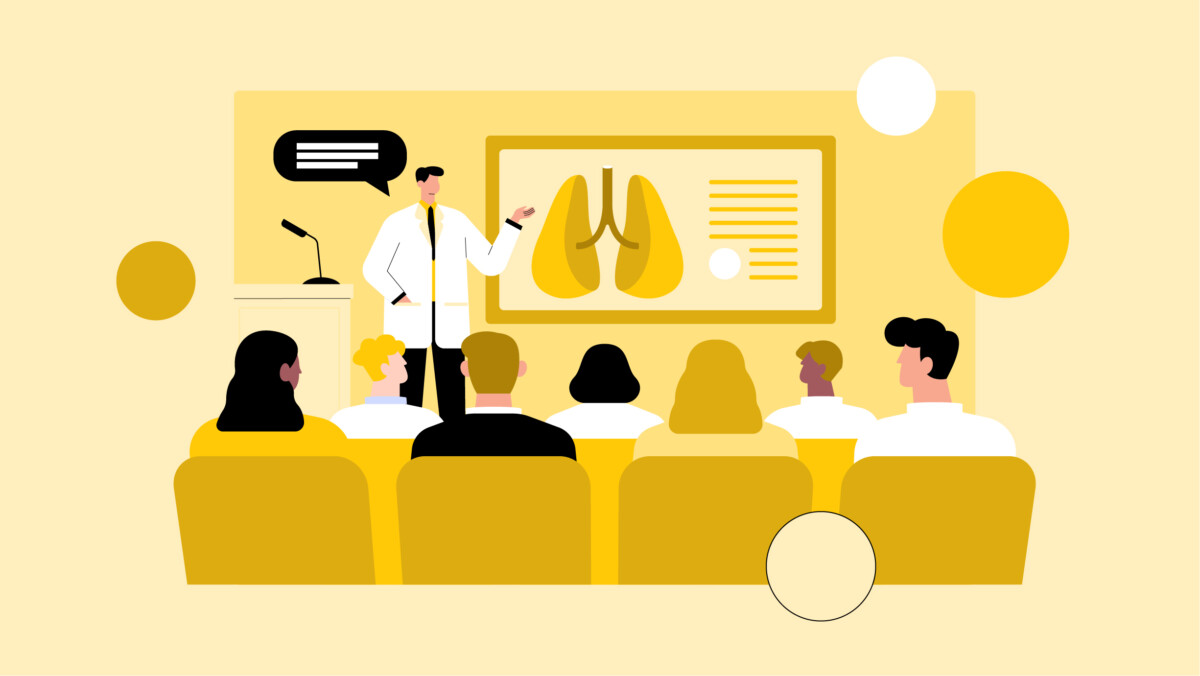
A staggering 2 out of 3 physicians on Sermo report that inadequate medical school training negatively affects their clinical confidence or decision-making. All physicians know graduate school prepares you to diagnose disease, interpret labs, and manage crises. But when you step into practice, you quickly realize that clinical knowledge is only part of the equation.
A general practitioner shares what most physicians feel upon graduation, “Medical school gave me the clinical tools but almost nothing about the system around it.”
Sermo is an expert community where physicians share experiences, seek advice, and fill knowledge gaps on all the things you weren’t taught in school. If you’re feeling shell-shocked from practicing in the real world, join the conversation with fellow physicians to gain practical insights and support that traditional medical education misses.
This article explores critical areas that medical school doesn’t teach you, helping physicians translate theoretical knowledge into practical expertise.
Why medical school leaves gaps in real-world practice
Despite the evolution of medical education, it still has shortcomings. While curricula include new evidence-based medicine and patient safety, they often fail to address daily realities: challenging patient communication, negotiating contracts, managing burnout, understanding reimbursement models, and navigating healthcare systems.
Medical school inadequately prepares students for real-world clinical practice by emphasizing certainty and linear thinking over the inherent uncertainty and complexity of actual patient care. This creates challenges when graduates encounter the ambiguous and variable nature of clinical environments.
53% of surveyed physicians on Sermo feel that these training gaps occasionally impact their decision-making. 15% agreed that these blind spots impact their clinical confidence, whereas only 11% of them feel this has no effect on their decision-making.
“Today’s students have access to more resources, but fundamental deficiencies remain. Understanding treatment is one thing; knowing how to apply it in real practice is another,” explains a resident in rheumatology on Sermo. This sentiment resonates across specialties, highlighting a disconnect between what medical education delivers and what real-world practice demands.
When physicians were asked which areas were most under-addressed in their medical education, 21% cited practice management, 15% personal finance, and another 15% mental health and well-being. Smaller but notable percentages highlighted deficiencies in end-of-life conversations (8%), insurance and reimbursement (13%), and AI and digital health tools (13%).
These physicians indicated that they fill these gaps through on-the-job learning (40%), online resources (26%), CME courses (14%), and independent study (11%). “Most of what I learned came from real cases, good colleagues, and trial-and-error. You grow fast when the system doesn’t wait for you to catch up,” recommends an emergency medicine physician.
While some schools integrate practical competencies, most physicians still enter practice feeling underprepared for the non-clinical challenges that define much of their careers.
Business of medicine and practice management
Doctors are trained to practice medicine, not manage a business. That’s why practice management ranks as the most neglected area, with 21% of surveyed physicians choosing it. The problem is, understanding the business of medicine for physicians isn’t optional; it’s essential.
For example, the physician employment contract you sign may be the most important financial document of your career. Still, many admit they entered negotiations with little understanding of RVUs, tail coverage, non-compete clauses, or restrictive covenants. The complexities of insurance systems, billing codes, and reimbursement models often feel like a foreign language.
“The biggest gap is healthcare management, or the business of healthcare, which is perhaps the most important but missing from formal training,” observes a pathologist on Sermo.
Without knowledge in budgeting, staffing, regulatory compliance, and quality metrics, even excellent physicians can struggle to maintain viable practices. The business side extends to understanding healthcare economics, value-based care models, and how hospital decisions affect clinical workflows.
For physicians seeking to fill this gap, CME for practice management is increasingly available. Sermo’s physician resources provide physician-led insights into topics like practice management, where physicians can find peer advice on everything from negotiating contracts to optimizing team efficiency.
Mental health, burnout, and physician well-being
15% of surveyed physicians identified mental health and well-being as a major training gap. The medical profession has one of the highest rates of burnout and suicide, with physician burnout rates as high as 63% during the COVID-19 pandemic and currently around 48%.
“We’re trained to identify and treat suffering in others, but we often fail to recognize it in our own reflection,” shares a general practice physician on Sermo.
Another GP elaborates: “The chronic stress inherent in medical practice makes us more vulnerable, not immune. The long hours, the high emotional toll, the pressure to make no mistakes, and the lack of work-life balance lead us to normalize a state of extreme burnout. We accept fatigue as part of the job and dismiss the warning signs as weaknesses. “There’s no time,” “it’s part of the job,” or “someone else needs it more than me” are phrases that become our mantra, a form of armor that temporarily protects us but ultimately consumes us.”
A 2025 review by Harvard Medical School explains that burnout rates in medical students and residents rise sharply during training, yet wellness and self-care education remain inconsistent, prompting the Accreditation Council for Graduate Medical Education (ACGME) to mandate basic well-being training in recent years. Medical education rarely provides structured training in stress management, work-life balance, or recognizing depression and burnout in oneself. The emotional impact of patient deaths, medical errors, or constant exposure to suffering is seldom discussed.
Burned-out physicians make more errors, have worse patient outcomes, and are more likely to leave medicine. Yet during training, there’s little emphasis on work-life balance or physician mental health wellness. However, there is hope for change. Recent studies suggest positive movement. A 2025 scoping review identified successful interventions such as peer mentorship, reflective writing, wellness curricula, and faculty-led coaching, highlighting the need for sustained, systematic well-being instruction at all stages of medical training.
Financial literacy and personal development
15% of surveyed physicians identified personal finance and student debt as needed training areas. Given that the average medical school graduate carries $250,000 in debt, this gap is serious.
“I’m still learning about RVUs in residency and retirement, but it would have been nice to have explored this option more while in school,” admits a resident in internal medicine.
Financial literacy for doctors covers loan repayment strategies, loan forgiveness programs, and refinancing options—decisions that can save tens of thousands of dollars over time. Many physicians make them without guidance during residency.
Beyond debt, physicians must understand compensation structures, tax planning, retirement savings, insurance, and investments. Early planning matters: contributing to retirement accounts during residency builds substantial long-term wealth, yet this is rarely emphasized.
Estate planning, asset protection, and practice structure choices all require financial literacy. Many physicians later regret early decisions made without adequate knowledge.
Sermo offers extensive resources through our financial planning archives, where physicians can learn more about contract negotiation, side hustles, retirement planning and more.
Communication and leadership
While medical schools teach communication skills, holes remain in preparing physicians for real-world interactions.
Patient communication training for physicians often focuses on taking patient history and delivering diagnoses, but can neglect nuanced conversations such as bedside manner, end-of-life care, breaking bad news, or handling family disagreements.
Research shows that these “serious illness” discussions are among the most critical yet underdeveloped skills in clinical practice. Studies have found that conversations about care goals such as what matters most to a patient, their fears, and acceptable trade-offs improve quality of life, patient satisfaction, and care alignment, without increasing distress. Yet these talks often happen too late in the illness trajectory or are led by clinicians who lack sufficient training in facilitating them.
While effective leadership is critical for optimizing team performance, enhancing patient safety, and reducing burnout, many students and residents receive limited guidance beyond clinical and technical skills. But the best healthcare leaders possess a blend of clinical knowledge and soft skills.
Insurance and reimbursement
13% of physicians selected insurance and reimbursement as the most under-addressed part of medical education. Understanding these systems goes far beyond knowing payer types.
Physicians must grasp prior authorizations, coverage limits, and how to advocate for patients when care is denied. They also need coding accuracy for proper reimbursement and awareness of how value-based care models affect compensation.
Many physicians express frustration battling insurance companies. Understanding which battles to fight and how to document effectively are skills primarily learned through trial and error.
These administrative burdens, including paperwork and authorizations, contribute to burnout and stress; however, medical school offers little training in managing them effectively.
Legal and ethical dilemmas
8% of surveyed physicians identified legal and ethical dilemmas as areas that medical school didn’t teach them. Even a single misstep can have career-altering consequences, with the average physician spending an average of 11% of a 40-year career with an open malpractice claim. And this isn’t even the only legal risk you could face.
“One mistake in documentation or ethics can follow a doctor for years. We teach the science, we should also teach how to protect ourselves and our patients legally,” emphasizes an emergency medicine doctor.
Medical ethics courses cover theory but rarely prepare physicians for the daily ethical challenges they face, such as family disagreements, policy conflicts, or disclosure after an error. Legal understanding is equally limited: malpractice, documentation, informed consent, and handling subpoenas or depositions are often self-taught.
The intersection of law and ethics is especially complex in capacity assessments, involuntary treatment, reproductive health, and end-of-life care. These require not just clinical judgment but legal literacy and standards of procedure.
Technology, AI, and the future of training
13% of surveyed physicians on Sermo cited AI, technology, and digital tools as neglected aspects of medical education. This gap is predicted to grow as technology becomes further embedded in medicine.
Electronic health records have transformed documentation, yet many physicians receive minimal training in using them efficiently or transitioning EHR systems when necessary. Artificial intelligence in healthcare now aids diagnosis and prediction, but most physicians lack understanding of its function or limitations.
Digital health, telemedicine, and remote monitoring are redefining care. Physicians must know how to maintain patient relationships virtually and assess the evidence behind new tools.
“There is a trend towards implementing more integrative programs… but finances, reimbursements, and personal health are still lacking,” observes a resident in gastroenterology.
While medical education is adapting and extracurricular CME and online training are helping to fill gaps, the pace of change in curricula lags behind real-world innovation, especially in the realm of AI and digital tools.
Key takeaways
Despite progress, physicians still feel underprepared for the non-clinical aspects of practice, like business management, financial literacy, mental health resilience, communication skills, legal knowledge, and technology.
Sermo’s poll shows that only 1% of physicians felt their training was comprehensive and left no gaps. When asked if today’s students are better prepared, 47% said “somewhat,” while 25% said “little has changed.”
These holes in training underscore the importance of physician on-the-job training and peer learning. The Sermo community helps physicians learn from each other, ask questions without judgment, and access resources addressing real challenges.
Medical education constantly evolves, yet each new generation of graduates will encounter unforeseen challenges. The crucial question isn’t whether these gaps exist, but how physicians will bridge them. Key to developing competencies not covered in medical school are peer learning, mentorship, online resources, and communities like Sermo.
Join Sermo today to connect with peers who understand these blind spots and can help you illuminate them to grow your career and impact.















